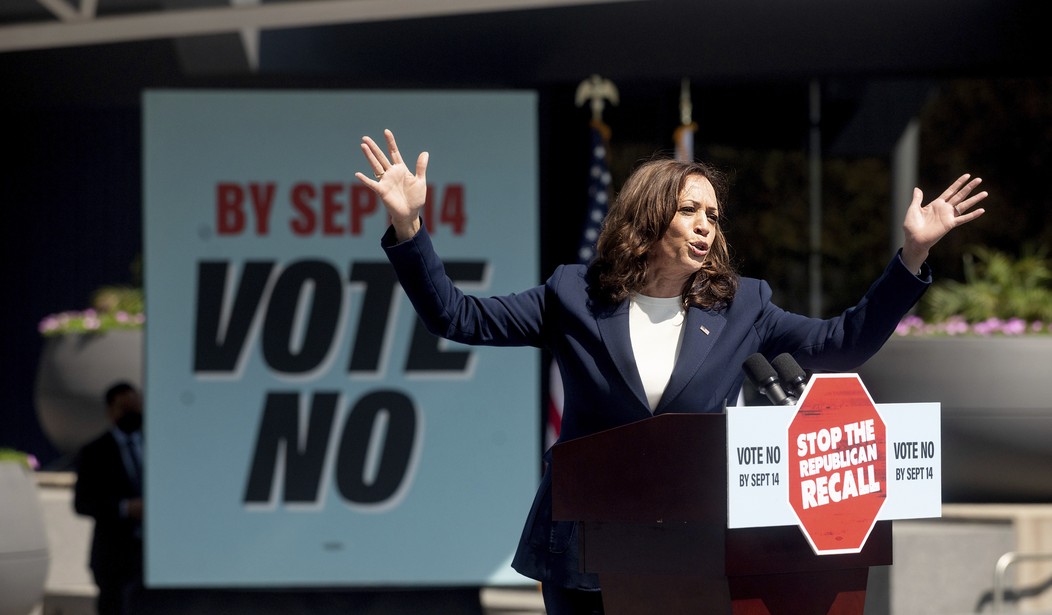(EDITOR'S NOTE: This piece was originally posted in November 2022 but has been updated to reflect the 2024 election results.)
As regular readers know, I have an illogical love for my home state of California, and despite the loud and persistent calls from many conservatives to abandon it, I steadfastly refuse. Still, I am not under any delusions about the efficacy of our government or the sensibility of our laws – and they tend to get more stupid as the years go by.
Right now, the country’s waiting for California to finish counting ballots from an election held a week ago, and House races called just one day ago determined GOP control. Why is it taking so long? And what does it mean to “cure” a ballot?
The short answer is that under California law vote-by-mail mail ballots postmarked by Election Day are valid if they are received by the county within seven days after Election Day. So, ballots are being received through today, Tuesday, November 12, and you can't finish counting until you have all of the items to count in hand.
Before I go into more detail on the topic I want to make it clear that I am not in favor of any of the laws I'm about to discuss; I believe that universal mail-in voting should be stopped and that there should be a requirement that any absentee ballots cast in an election be received by the time polls closed, not simply postmarked by that date.
Believe it or not, California’s election process wasn’t always so lengthy or chaotic. How did we get here? In 2016 a trio of bills were passed that, together, significantly changed how California’s election process works:
- SB 450, Voter’s Choice Act
- Requires mail ballots to be sent to all voters in a participating county
- Requires elections officials to forward ballots they receive from voters in other counties to the appropriate county
- Eliminates precinct-based polling places in favor of county-wide “vote centers” and 10 days of early in-person voting
- AB 1921, legalized ballot harvesting statewide
- Allows any person a voter designates to return their ballot for them
- A ballot harvester can hold a ballot for up to 72 hours before delivering it to election officials
- No training or accreditation required; no registry of ballot harvesters or chain of custody
- The harvester is supposed to sign their name on the ballot, but the ballot will be counted even if the harvester’s signature is missing
- AB 1461, Motor Voter Act – automatically registers people to vote when they interact with the DMV unless they opt-out
Then, in 2020 vote-by-mail ballots were sent to all registered voters due to the COVID pandemic. Since nothing in government is ever temporary, that practice was made permanent – with a few additional provisions – when AB 37 was passed by the Democrat supermajority and signed by Gov. Gavin Newsom in 2021.
Critics of California’s extremely permissive election laws say the system is designed for rampant fraud, and that said fraud is occurring. Apologists for the system say it’s secure because there is signature matching and ballot tracking, and because there are criminal penalties for forging signatures, for paying harvesters per ballot collected, and for paying voters to turn over their ballots. We’ll go through those factors.
But first …
California election officials haven’t been able to count all the ballots yet because under AB 37 they have to accept ballots postmarked by Election Day for seven days after Election Day. So, there’s no way to know exactly how many ballots are outstanding until mail ballots received today are tallied. AB 37 requires counties to:
- Mail a ballot to every registered voter for every election
- Allow any voter — not simply voters with disabilities or military/overseas voters — to cast a ballot using a remote accessible vote-by-mail system (print-at-home ballots)
- Accept mailed ballots postmarked by Election Day up to seven days after Election Day (instead of the previous three days)
- Implement a ballot tracking system accessible by all voters, including those with disabilities
Counties are also permitted to begin counting vote-by-mail ballots 29 days before Election Day instead of 15 days before, but the counts are not allowed to be viewed or released before 8 PM on Election Day. It should be easy to determine if the counts were accessed prior to that time by reviewing activity logs, but that depends on who’s watching the activity logs.
Thanks to SB 450, every county has numerous ballot drop boxes in which ballots can be deposited. Most of the time they’re located near government buildings like libraries, fire stations, or a City Hall, but some are out in remote areas at state parks. In addition, voters can drop them at any vote center in the county. Then, we have the least secure method for returning a vote-by-mail ballot: the United States Postal Service. California even allows a “bona fide private mail delivery company” to deliver ballots to the elections official. There are so many holes in the “postmarked by Election Day” provision in AB 37 and received within seven days that it’s rendered meaningless:
(b) Notwithstanding subdivision (a), any vote by mail ballot cast under this division shall be timely cast if it is received by the voter’s elections official via the United States Postal Service or a bona fide private mail delivery company no later than seven days after election day and either of the following is satisfied:
- The ballot is postmarked on or before election day or is time stamped or date stamped by a bona fide private mail delivery company on or before election day, or it is otherwise indicated by the United States Postal Service or a bona fide private mail delivery company that the ballot was mailed on or before election day.
- If the ballot has no postmark, a postmark with no date, or an illegible postmark, and no other information is available from the United States Postal Service or the bona fide private mail delivery company to indicate the date on which the ballot was mailed, the vote by mail ballot identification envelope is date stamped by the elections official upon receipt of the vote by mail ballot from the United States Postal Service or a bona fide private mail delivery company, and is signed and dated pursuant to Section 3011 on or before election day.
(c) For purposes of this section, “bona fide private mail delivery company” means a courier service that is in the regular business of accepting a mail item, package, or parcel for the purpose of delivery to a person or entity whose address is specified on the item.
Wait, what? Hypothetically, one could contract with “a courier service that is in the regular business of accepting a mail item, package, or parcel” for delivery to any government building (and there are plenty of them) and just have ballots delivered within that seven-day time frame, without any information from that courier service as to when they were “mailed,” and as long as the voter dated the ballot envelope on or before election day, it would be counted. Or, if somehow a batch of ballots wasn’t postmarked as it went through the USPS, but got to the elections official within seven days, all good. Don’t get me wrong; I’m not saying that is happening. Rather, it seems there are so many exceptions to the “deadline” for postmark and nebulous definition of “mail delivery company” that there’s a lot of room for, ah, individual interpretation in the absence of case law forcing a more narrow definition.
We still haven’t gotten around to the act of ballot harvesting itself. There’s confusion about what ballot harvesting is. It’s not gathering up blank ballots. As I wrote in 2020:
Ballot harvesting is when a person who is not related to a voter, and who may be employed by a political campaign, a political party, an interest group, a PAC, or whomever, or who may simply be a volunteer, takes possession of a completed, sealed mail ballot from a voter and returns that ballot to elections officials for the voter.
Ballot harvesting is not supposed to include “helping” a voter fill out their ballot, filling out the ballot for them, helping a voter research candidates, encouraging them to vote for a particular candidate, or paying for a voter’s blank ballot. I say “not supposed to include” because, as I wrote previously, there is evidence of Democrat activists, volunteers, and paid gatherers did just that in California’s 2018 general election. One even admitted as much to the Los Angeles Times.
There’s even a Ring video of one Democrat harvester offering to help voters figure out who to vote for during the 2018 general election in California.
That year, the first major election for which ballot harvesting was legal in California, 14 counties participated in the Voter’s Choice Act pilot program — which required election officials to send a vote-by-mail ballot to all voters — including Orange County. Coincidentally, four of the seven seats Dems flipped that year were in Orange County, and many of them have now flipped back to the GOP. A fifth seat, CA-25, was won by Katie Hill, but has been represented by the GOP since her resignation. The other two seats, in central and northern California, have gone back to GOP representation, proving what many of us believed at the time – unchecked ballot harvesting won those seats for the Dems and the districts weren’t really purple or blue.
And then we get to the chain of custody issue, which I discussed at length in a May 2020 piece. Essentially, even though the ballot harvester is to sign the ballot envelope, the ballot will still be counted without a ballot harvester signature so there’s no pressure for them to sign it. And if the ballot harvester walks the ballots into the elections office they are not asked for identification to drop off, so there is literally no way to track who harvested the ballot and when. If a voter trusts a stranger with their ballot, there is no recourse if that ballot doesn’t show up at the elections office. And there is no way to charge that harvester criminally since no one knows who they are.
RELATED: CA's Ballot Harvesting Law Leads to Insecure Elections; Here's How to Reform It
Finally, what does it mean to “cure” a ballot? The California Elections Code requires election officials to notify voters if the ballot is invalid due to no signature or a signature mismatch and give them the opportunity to “cure” that deficiency within a specified period of time so that the ballot can then be counted. It’s not an opportunity to change a vote, and election officials are not allowed to open the ballot.
There are numerous security issues with current vote-by-mail and ballot harvesting laws in California and in other states. Republicans should work to modify those laws but also plan to operate within the existing framework until we gain enough votes to fully do away with ballot harvesting.















Join the conversation as a VIP Member